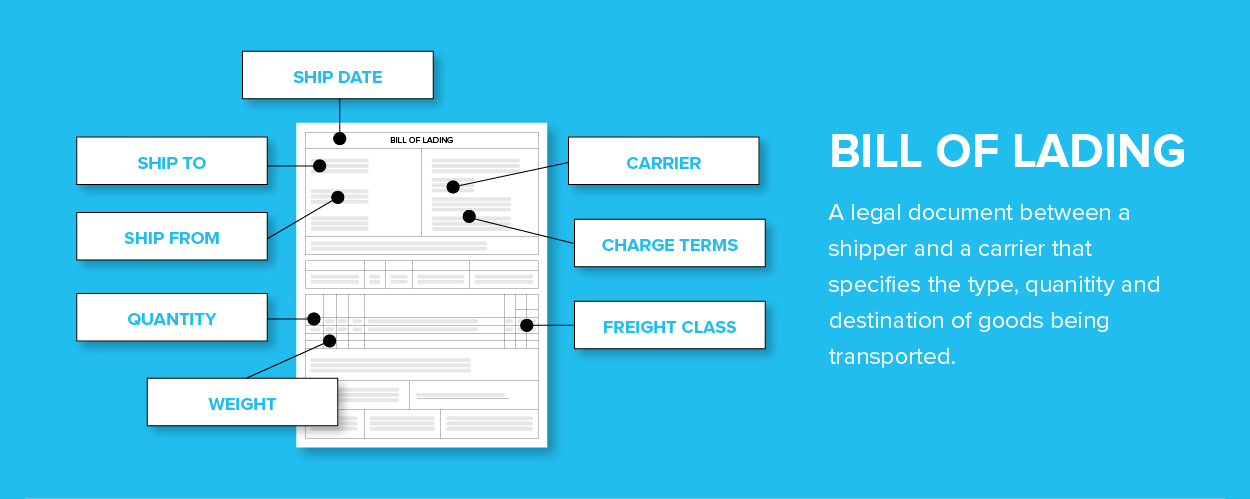If your business relies on shipping goods or materials, you need to know your way around documents like bills of lading to ensure your shipments survive and arrive as planned. What is a bill of lading?
Put simply, a bill of lading, often referred to as the ‘original bill’, is a binding legal document that plays a significant role in freight shipping, logistics, and international trade.
A Bill of Lading is not to be confused with a freight bill, which is essentially an invoice for the transportation services provided. While a BOL is a legally binding document that serves multiple functions, the freight bill is focused solely on the cost and payment details of the freight shipment.
Below, we’ll explore the importance and history of bills of lading. We’ll also discuss how to make a bill of lading so that you can select the right type and ensure you fulfill all of your shipping responsibilities.

Introduction to Bill of Lading (BOL)
As mentioned, a bill of lading is a binding legal document. It serves multiple purposes during transport as a:
- Document of title to the goods described in it,
- Receipt of goods for the shipped items, and
- Contract that lays out the terms and conditions of the transport.
The word “lading” refers to loading cargo onto a ship or vessel. Traditionally, a bill of lading was applied to transport that traveled either wholly or in part across oceans, but today they’re used for other methods of transport as well.
The Historical Origins of the Bill of Lading
Back in the mid-14th century, trade by land and sea was common. However, a bill of lading was still far off in the future—unfortunately so for some seafarers. A statute dating from around 1350 held that any clerk, essentially an early freight forwarder, who falsified information on a ship’s register about goods in transit “should lose his right hand, be marked on the forehead with a branding iron, and all his goods be confiscated.”
The first known standalone document similar to a current bill of lading dates from 1390, for a shipment of wax and hides deliverable to Pisa in central Italy. Since then, regulations and practices across ports and countries have differed and evolved.
In the United States, current practices are guided by the Federal Bill of Lading (or Pomerene) Act of 1916, as stated in the U.S. Code Chapter 801, Bills of Lading, under Title 49, Transportation.,
International conventions have been more difficult to codify. A bill of lading that includes maritime travel today should identify the set of rules that governs it, whether:,
- Rotterdam Rules of 2009
- Hamburg Rules of 1992
- Hague Visby Rules of 1968
- Hague Rules of 1924
These codified rules provide guidance on practices and remedies related to the transport of goods. This includes everything from ship maintenance requirements to how to choose the country in which to pursue an international shipment gone wrong lawsuit.
Key Components of a Bill of Lading
Since they serve as both a legally binding contract and a thorough set of instructions on the receipt, shipment, storage, and delivery of goods, bills of lading communicate a significant amount of data.
Key information includes:
- Who – Names and contact information for the shipper (consignor) of the goods, the transporter (or carrier) responsible for moving them, and the receiving party (consignee or buyer) who will take possession of them when they arrive at their destination.
- What – A description of the items being shipped including quantity, value, type of packaging, dimensions, weight, number of packages for grouped freight, and any required notifications of hazardous materials.
- Where – The point of origin where the goods will be handed off to the carrier and the exact destination (or destinations) they’ll be delivered to the receiving parties.
- When – The ship date, requested arrival date or range, and other schedule and deadline details.
- How – The method and terms of transport, freight class, specific receipt or delivery services required, and any special handling needs.
Because the bill of lading is a legal contract between the shipper and the carrier (and then the carrier and the receiver), it also:
- Requires signatures by authorized shipper, carrier, and receiver representatives
- May include additional identification and tracking numbers, such as purchase orders
Different Types of Bills of Lading
As if there aren’t enough moving parts, bills of lading also come in a rainbow of flavors. A specific bill of lading type may refer to the method of transport, the condition of the goods, limits on liability, or transferability of the contract itself.
Common types of bills of lading include:
- Uniform Bill, or straight bill – The most common bill of lading. It’s a non-transferable, boilerplate template that identifies limits on carrier liability, particularly based on specific types of cargo.
- Through Bill – A complex bill of lading that allows for both domestic and international transport. It typically covers multiple methods of transport and multiple carriers and is often required for the export of goods.
- Negotiable Bill, or order bill – A bill that’s transferable to a third party through consignment if the goods are clean (as described and without defect). It’s typically used when the shipper wants to enforce terms and conditions of shipment and inspection of cargo prior to release to the receiver, and when the receiver’s payment for goods is based on a letter of credit.,,
- Non-negotiable Bill – A bill that’s not transferable to another party, and must be accompanied by other documentation to represent ownership.
- Ocean Bill – A bill that’s used for sea freight transport of cargo across international waters.
- Inland Bill – A bill for non-oceanic transport of goods via road, rail, or inland waterway.
- Clean Bill – A bill that indicates that goods have been received as described and without defect upon inspection.
- Claused Bill, or fouled bill – A bill that indicates, upon inspection, that goods are damaged, defective, or not as described.
Legal Significance of Bill of Lading in Transportation
A title of ownership, a receipt, and a contract for services—serving all three purposes means this document is pivotal for legal protection and actions.
A bill of lading or lading document is legally significant for all parties involved in the shipping process. It can help:
- Hold shippers liable if received goods don’t match the bill of lading terms
- Identify where goods went missing in a delivery chain
- Pursue recompense for damages to goods in transit
Because a bill of lading involves multiple parties signing off and clear, detailed directions, it’s also a critical part of a company’s internal controls and segregation of duties to prevent theft and fraud.
Roles and Responsibilities Outlined in a Bill of Lading
If you mail a love letter, it’s a transaction that includes you, the United States Post Office, and your sweetheart. Similarly, the parties outlined in a bill of lading include:
- Shipper or consignor – The current owner of the cargo in question with the authority to sign it over for shipment.
- Carrier – The carrier who takes possession of the goods and delivers them to the destination. For a through bill of lading, there are typically multiple carriers listed along the delivery chain
- Receiver, consignee, or buyer – The party who takes possession of the delivered goods.
Plus, a bonus role:
Notify party – Individual to inform when goods reach their port or other destination.
Common Mistakes to Avoid When Filling Out a Bill of Lading
A useful bill of lading is filled out accurately and in detail, but there’s always the possibility of human error or outdated information sources. Double-check that you get these easy-to-miss steps correct:
- List current, accurate contact details for every individual and entity
- Ensure counts are accurate and accurately titled (product, package, pallet load, etc.)
- Use the correct type of bill of lading
- Provide a complete description of the goods that can illuminate the presence of damage
How Technology Is Changing Bill of Lading Management
Early examples of bills of lading feature scrawling calligraphy, written by hand on parchment. As such, you can imagine cheers going up as typewriters, mimeographs, and copy machines were introduced—let alone today’s technology, which goes much farther than quick typesetting and multiple copy production.
In fact, BOL management software now allows for electronic bills of lading to be generated on platforms that:
- Connect to real-time data
- Provide secure digital signing
- Integrate with billing, accounting, and transportation management systems
- Offer high-res mobile scanning of paper documents
- Provide analytics-based recommendations to improve efficiency
With these features available, relying on emails and other types of file sharing to handle bills of lading is almost as outdated as a note in a bottle.
Why the Bill of Lading Is Crucial for Lojistic Clients
It’s more than just shifting objects from point A to point B. With all the moving parts involved in the shipping process—multiple sets of laws, types of shipping, item-specific rules, and limits—any “i” not dotted or “t” not crossed can cause trouble.
But getting bills of lading right goes beyond the delivery phase. All the information they contain has the potential to generate forward-facing analytics and past-project audits that help you improve efficiency and capture any refunds and damages due to you through shipper or receiver error.
At Lojistic, we offer a no-cost path to transform your shipping game. Our platform audits your shipping invoices, pursues refunds owed to you and can help you procure lower rates with the carriers.
Check out success stories, explore our virtual demo account, or learn more about how you can reduce your shipping costs and increase your profit with Lojistic.

Author
Bryan Van Suchtelen
Bryan Van Suchtelen
Corporate Director of Parcel Rate Services
Prior to joining Lojistic in 2015, Bryan enjoyed a 26-year career with UPS where his roles included Pricing, Field Sales and Director-level Sales Management of some of UPS’s largest customers.
At Lojistic, Bryan leverages his wealth of experience/expertise to identify and execute supply chain cost management solutions for parcel shippers of all sizes. Bryan has helped his customers reduce their shipping spend by tens of millions of dollars.

